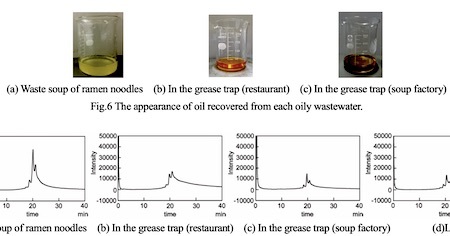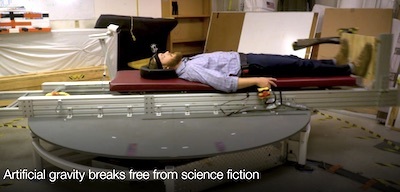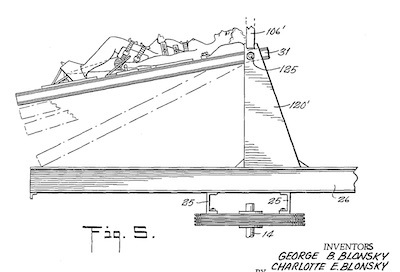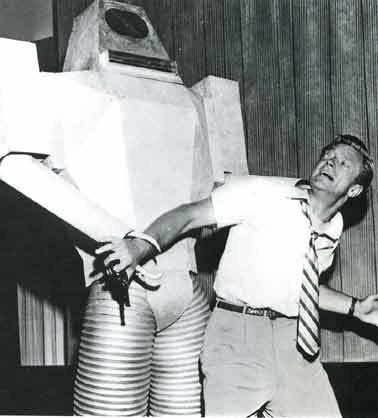Marc Abrahams's Blog, page 139
August 28, 2019
A newish twist, by a man named Olds, on a screwy old idea
The Olds elevator is a fairly simple machine that apparently no one thought up until recently. It’s a fairly new twist, by a man named Olds, on a screwy old idea: Archimedes lifting screw:
Peter Olds has US patent #US7314131B2, which describes the invention.
(Thanks to Mark Dionne for bringing this to our attention.)

August 27, 2019
Suspecting an Earthquakes/Terrorism Link
Detective work sometimes involves hazarding guesses about hazards, as this study demonstrates:
“Earthquakes and Terrorism: The Long Lasting Effect of Seismic Shocks,” José G. Montalvo and Marta Reynal-Querol, Journal of Comparative Economics, epub 2019. (Thanks to Manuael ANsede for bringing this to our attention.) The authors, at UPF-BarcelonaGSE-IPEG, and UPF-ICREA-BarcelonaGSE-IPEG, Barcelona, Spain, explain:
“In this paper, we study the relationship between earthquakes and terrorism. In the short run, the destruction generated by a medium-range earthquake reduces the opportunity cost of rebelling against the government…. In the medium run the destruction of tangible assets can lead to the closing down of weak firms, the introduction of new technologies, the improvement of productivity and the increase in wealth inequality We propose a new algorithm to… show that the likelihood of a domestic terrorist event increases with the previous occurrence of an earthquake.”

August 26, 2019
Wine bottle bottom dimple enigma
 Why do wine bottles (usually) have a raised-up internal dome-like structure [its technical name is a ‘punt’] at the bottom of the bottle?
Why do wine bottles (usually) have a raised-up internal dome-like structure [its technical name is a ‘punt’] at the bottom of the bottle?
If you have a theory about such things, yours can be compared to a substantial list of possible explanations – bearing in mind that experts in the field are as yet undecided as to which one(s) might be correct. They include (but are not limited to) :
● Having the function of making the bottle less likely to topple over.
● Allowing bottles to be more easily stacked end to end.
● Taking up some volume of the bottle, causing it to appear larger for the same amount of wine.
See: Wikipedia
Photo Credit: Aurélien Mole @ Wikipedia

August 23, 2019
Boom! “Science that’s hard to take seriously and even harder to ignore”
Scott Lafee‘s Wellnews syndicated column often presents tidbits about things that have won Ig Nobel Prizes. Here’s the most recent (August 19, 2019):
Ig Nobel Apprised
The Ig Nobel Prizes celebrate achievements that make people laugh and then think — a look at real science that’s hard to take seriously and even harder to ignore.
In 2012, the Ig Nobel Prize in medicine went to a pair of French researchers for their advice to doctors performing colonoscopies on how to minimize their patients’ chance of exploding.
More about those explosions…
The 2012 Ig Nobel prize for medicine was awarded to Emmanuel Ben-Soussan and Michel Antonietti [FRANCE] for advising doctors who perform colonoscopies how to minimize the chance that their patients will explode.
Here are two of their several medical publications about this:
“Colonic Gas Explosion During Therapeutic Colonoscopy with Electrocautery,” Spiros D Ladas, George Karamanolis, Emmanuel Ben-Soussan, World Journal of Gastroenterology, vol. 13, no. 40, October 2007, pp. 5295–8.
“Argon Plasma Coagulation in the Treatment of Hemorrhagic Radiation Proctitis is Efficient But Requires a Perfect Colonic Cleansing to Be Safe,” E. Ben-Soussan, M. Antonietti, G. Savoye, S. Herve, P. Ducrotté, and E. Lerebours, European Journal of Gastroenterology and Hepatology, vol. 16, no. 12, December 2004, pp 1315-8.

August 22, 2019
Recent progress in robotic topiary
The ever expanding list of professional activities that are in imminent danger of replacement by AI and/or robots has a new addition – Topiarists. A topiary-bot is currently under test at Wageningen University, The Netherlands, as part of the the university’s TrimBot2020 project. Which is seeking to “advance the robotics and computer vision technology needed by a garden trimming robot”.
The team’s clipper bot was tested on small boxwood trees – both real and artificial. It performed slightly better on the plastic trees. See:
Automated Boxwood Topiary Trimming with a Robotic Arm and Integrated Stereo Vision IEEE/RSJ International Conference on Intelligent Robots and Systems (IROS), 2019
Bonus Assignment [optional] Estimate, if appropriate (with explained rationale) the remaining time before the profession of ‘Hairdresser’ might become redundant.
Research research by Martin Gardiner

August 21, 2019
fucK Gene Polymerase Chain Reaction on Sputum
This provocatively-titled study adds a new way in which one can analyze sputum for medical purposes:
“Quantitative fucK Gene Polymerase Chain Reaction on Sputum and Nasopharyngeal Secretions to Detect Haemophilus influenzae Pneumonia,” Guma M.K. Abdeldaim, Kristoffer Strålin, Per Olcéne, Paula Möllinge, and Bjorn Herrmann, Diagnostic Microbiology and Infectious Disease, vol. 76, no. 2, June 2013, pp. 141-146.
The authors are at Uppsala University, National Center for Diseases Control, Benghazi, Libya, Örebro University, Sweden, and Karolinska University, Sweden.

August 19, 2019
Recycling of Ramen Noodles Waste Soup
Industrial energy recovery from waste soup of ramen noodles is feasible, suggests a new study.
The study is: “The recovery of oil from a lot of oily wastewater and the production of biodiesel from its oil,” Chihiro Kondo, Hiroki Sano, Nobuki Ichimiya, Koji Yamane, and Kiyoshi Kawasaki, Transactions of the JSME, vol. 85, no. 874, 2019. The authors, at Okayama University of Science, Ridai-cho, and The University of Shiga Prefecture, Japan, report:
“This paper describes how to produce a biodiesel fuel (BDF) from the waste soup of ramen noodles, especially focusing on the recovery process of the oil (triglycerides) from a large amount of waste soup or the oily wastewater disposed of by pouring it down the sink by a ramen restaurant. By combining a semi-transparent bucket (~6 L) with a cock and solvent extraction, it is shown that oil can be recovered easily from 300 or more bowls of ramen noodle waste soup, with an energy profit ratio (EPR) of more than 5.2.”
(Thanks to Raymond Kunikane Terhune for bringing this to our attention.)
BONUS (only tangentially related): This video shows a more traditional, non-industrial, human-based method of extracting energy from ramen noodles waste soup:

A “Gyroscopic” no-spill cup-holder [new patent]
“For travelers, balancing luggage, a snack, personal items, and a drink can be difficult, often resulting in spilling of beverages either while walking around or while seated on, for example, a plane or in a car.”
 What one needs, perhaps, is a self-stabilizing drinks-cup holder? And, fortunately, a newly patented solution has become available. Inventor Donald Joseph Berg of Escondido, California, has just been granted a US patent for a ‘Gyroscopic cup holder’. It’s also applicable, they say, for use with bicycles, strollers, carts, boat railings, cars and trucks etc. etc..
What one needs, perhaps, is a self-stabilizing drinks-cup holder? And, fortunately, a newly patented solution has become available. Inventor Donald Joseph Berg of Escondido, California, has just been granted a US patent for a ‘Gyroscopic cup holder’. It’s also applicable, they say, for use with bicycles, strollers, carts, boat railings, cars and trucks etc. etc..
Note:
The word ‘Gyroscopic’ appears just once in the patent document (i.e. in its title). And perhaps that may be one time too many, as it doesn’t feature a gyroscope of any kind – relying instead on a dual-axis gimbal mechanism.
Also Note :
The 2017 Ig Nobel FLUID DYNAMICS PRIZE was awarded to Rouslan Krechetnikov [USA, RUSSIA, CANADA] and Hans Mayer [USA] for studying the dynamics of liquid-sloshing, to learn what happens when a person walks while carrying a cup of coffee.
REFERENCE: “Walking With Coffee: Why Does It Spill?” Hans C. Mayer and Rouslan Krechetnikov, Physical Review E, vol. 85, 2012.
Research research by Martin Gardiner

August 16, 2019
Put a spin on it: Whirling babies then, and adults in the future
Compare and contrast, if you will, this press release from the University of Colorado: “Artificial gravity breaks free from science fiction”
…and the Ig Nobel Prize-winning patent by George and Charlotte Blonsky: “Apparatus for facilitating the birth of a child by centrifugal force”

August 15, 2019
Computers no longer ‘morons’ – they’ve evolved to become ‘leaders’ [says new study]
“We want to start a theoretical and empirical discourse on the paradigm ‘computers as leaders’, because the world has changed since 1967, when Peter Drucker stated that computers are morons and make no decisions.”
– explain Jenny S.Wesche [of Freie Universität Berlin, Institute of Psychology, Division of Social, Organizational and Economic Psychology, Berlin, Germany] and Andreas Sonderegger [of University of Fribourg, Institute of Psychology, Fribourg, Switzerland ] in their new paper for the journal Computers in Human Behavior. Not only noting that :
“ […] computers have [also] begun to take over leadership functions, guiding and commanding human workers.”
but also :
“Computers are becoming intelligent entities and are already making decisions that seriously influence human work and life. They evolved from ‘tools’ to ‘partners’ to ‘leaders’ in their interactions with humans and conceptual coverage is in danger of falling short of this development.”
See: When computers take the lead: The automation of leadership currently in-press at the journal Computers in Human Behavior
Bonus Assignment [optional] Which current-day ‘leaders’, if any, could profitably be replaced by a computer?
Image Credit: still from ‘Target Earth’ 1954
Research research by Martin Gardiner

Marc Abrahams's Blog
- Marc Abrahams's profile
- 14 followers










